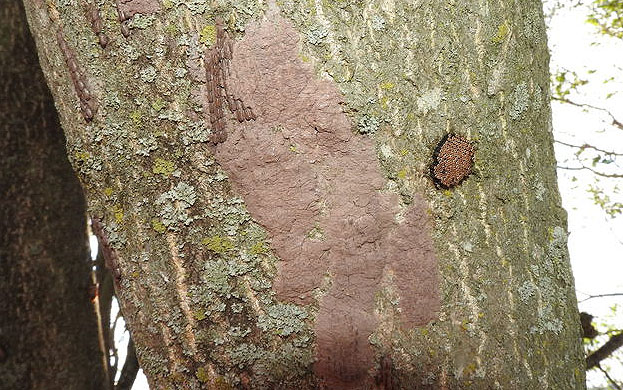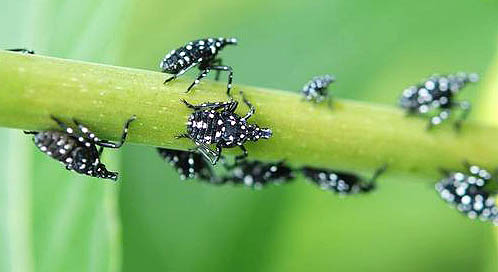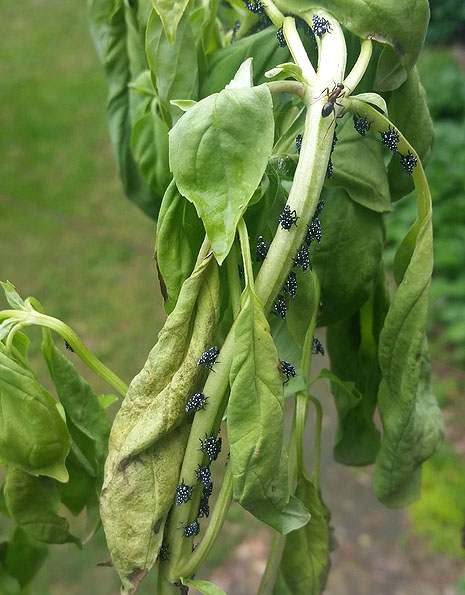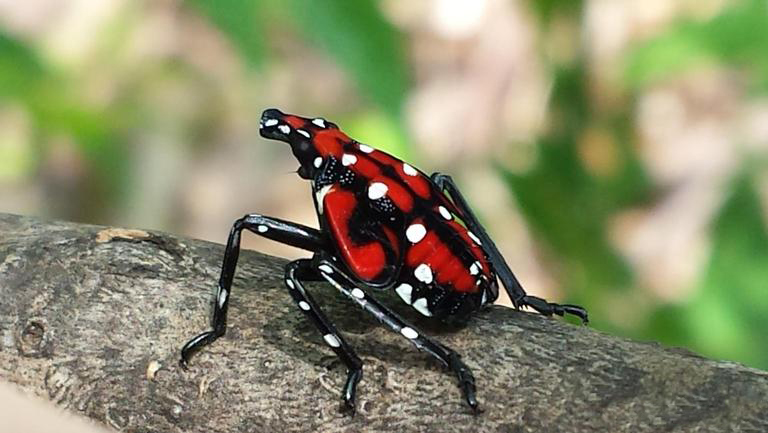SPOTTED LANTERNFLY.
WE NEED YOUR HELP TO STOP IT'S SPREAD.

Photo Lawrence Barringer, Pennsylvania Department of Agriculture,
Bugwood.org
Spotted lanternfly (Lycorma delicatula) is native to China but somehow hitched a ride to Pennsylvania back in 2014 and found it really likes it here. First found in Buck county it has since spread to 14 counties in southeastern Pennsylvania. This past year it has crossed the Delaware into New Jersey and been found in parts of New York and Delaware. So it is rapidly making marching across our country and decimating our crops. Pennsylvania placed a quarantine on affected areas but this seems to be totally ineffective as few people seem to even know about the problem so its impossible not to spread it. We need your help to spread the message and to be vigilant in spotting this invasive pest that could decimate parts of our food supply.
This is a beautiful insect. With its wings folded it looks appears sort of dusky pink and black with black spots. With the wings open it reveals the scarlet hind wings with black spots and bright yellow body. Even the nymphs are often pretty being black with red spots. If you see this creature its most likely to be as a nymph or sitting adult as they don't fly as much preferring to scuttle.
The problem is that Spotted Lanternfly tends to live in large groups, sometimes huge groups and the feed on the sap of many different plants. While it seems to prefer those of fruit trees and vines such as grapes, apples and many stone fruit trees like peaches. It will feed on almost anything include soy beans, wheat, corn and other major crops. It has also been found on hardwood trees used in the lumber industry like maple, walnut and pine as well as a range of ornamental shrubs used in landscaping.
This rapid spread could decimate our food crops and seriously impact the
lumber industry.
In PA alone this is a $18 billon industry. Many farmers have already had their
crops decimated with whole vineyards being wiped out by this voracious bug.
If it moves across the country most vineyards could be decimated with a possible
collapse of the wine industry as well as a severe lack of fruits in the market
as well as massive reductions in all kinds of other food crops. The landscaping
industry will also be greatly affected and homeowners will find their shrubs
and trees dying from a massive influx of the lanternflys.
The predicament is more complex and unpleasant than it first appears. Because lanternflys feed on plant sap they, like aphids, tend to exude a sticky 'honey dew' as a waste product. Because the insects are such voracious feeders this honey due can build up rapidly forming great sticky mats on driveways, cars, buildings and anything else that is left outside under trees or near bushes. There are even reports of 'honeydew stalagmites' where the buildup is so massive. Obviously few plants can sustain this kind of onslaught and they rapidly decline. If this is a tree then there is great danger of it falling and causing even more damage.
The increase in honeydew will also attract other unwanted insects such as wasps, yellow jackets and ants who feed on the sticky waste product. With such large food supplies these insects are increasing in numbers and can cause more problems for homeowners.
One of the major problems with Spotted Lanternfly is that its not fussy about
where it lays its eggs. While in its native country it normally restricts itself
to its favorite food the tree of heaven, here in the United states is branched
out. While tree of heaven is still a favorite and is sadly found across the
United States as an invasive tree the insects will lay eggs on almost anything.
Most commonly they lay on the trunks of trees but they have also been found
on almost any other kind of surface they can find including lumber, barrels,
sides of house and cars, trucks and other vehicles. This causes them to spread
rapidly across the country. In addition the adults have strong legs with little
hooks that allow them to cling onto vehicles for long periods allowing them
to be transported almost anywhere.
Because of this problem it is vitally important that everyone knows how to
spot these egg masses and know what the insects look like in all stages. If
you see any immediately contact the Penn
State Extension service and report it.
Life Cycle During the year.
JULY - DECEMBER
Adults
SEPTEMBER - JUNE
Eggs
APRIL - JULY
First to third instar - black with white spots small
JULY - SEPTEMBER
Forth Instar - red with white spots.
DAMAGE CAUSED BY SPOTTED LANTERNFLY.
PRESENT QUARANTINE IS NOT EFFECTIVE - see why
SPOTTED LANTERNFLY ADULTS
JULY - DECEMBER

Photo -Richard Gardner, Bugwood.org
Adults are most often seen on trunks of trees with Tree of Heaven being their most prefered tree. They are commonly found in groups.

Photo. Lawrence Barringer, Pennsylvania Department of Agriculture,
Bugwood.org
Adults are attractive insects appearing as a dusky rose color due to the scarlet hindwings showing through the semi transparent forewings which have characteristic spots and lines. This insect does not look like any other in North America so should be easy to identify.

Photo. Lawrence Barringer, Pennsylvania Department of Agriculture,
Bugwood.org
Adults are rarely seen flying. They tend to scuttle or hop. Flashes of the bright scarlet hindwings are often seen but spotted lanternflys seem to perfer to scuttle along so hindwings are rarely seen.

Photo. Lawrence Barringer, Pennsylvania Department of Agriculture,
Bugwood.org
Once eggs are laid though hundreds of adults can mature since they dont seem to have many if any preditors. Mass grouping like this are becoming more common. With this mass of insects feeding on this tree it most likely will not survive. Don't let this happen in your neighbourhood.
EGGS OF SPOTTED LANTERNFLY
SEPTEMBER - JUNE

Photo. Emelie Swackhamer, Penn State University, Bugwood.org
Female laying eggs on tree trunk. Most commonly the rows of eggs (in grey) are covered to prevent damage to the egges and to help to camoflage them so they blend in with the tree trunk or other surface they are laid on. They can be very hard to spot.

Photo. Emelie Swackhamer, Penn State University, Bugwood.org
Masses of spotted lanternfly eggs on a dead tree stump. The eggs blend into the bark of the tree making them hard to spot unless you are looking. Egg masses are laid on almost any hard surfaces (trees, decks, houses, outdoor equipment, rocks, etc.) and protected with a mud-like covering. Each egg mass contains 30-50 eggs.

Photo. Richard Gardner, Bugwood.org
Egg masses can be different colors. This group has more of a pinkish tinge but they can be grey, white or brown in color.

Photo. Lawrence Barringer, Pennsylvania Department of Agriculture,
Bugwood.org
Egg masses here are grey and white. The white tends to stand out on some trees but not on other surfaces.

Photo. Kenneth R. Law, USDA APHIS PPQ, Bugwood.org
These older eggs have lost any outer coating they had and the empty cells show that the little nymphs have hatched and gone looking for food.

Photo. Richard Gardner, Bugwood.org
While Spotted lanternfly perfers tree of heaven if its not around it will lay eggs on literally any surface and any tree. whjile many eggs are close to the ground they can be anywhere in the tree. This large pine tree has many egg masses on the branches.

Photo. Lawrence Barringer, Pennsylvania Department of Agriculture,
Bugwood.org
In this tree the many egg masses are much higher in the branches and would most likely need to be spotted using binoculars. If you suspect spotted lanternfly is in your area or garden check out the trees during the winter months to see if there are any egg masses. If so please report them.

Photo. Emelie Swackhamer, Penn State University, Bugwood.org
The egg masses on this smaller tree trunk are noticeable. The large number shows that there is a large population already in the area and its going to get much larger when these eggs hatch. If you go hiking check the trees you pass. If you see eggs report them and help stop the spread of these insects.

Photo. Lawrence Barringer, Pennsylvania Department of Agriculture,
Bugwood.org
Spotted Lanternfly is not fussy about where it lays its eggs as seen here on this metal drum. This could just as easily be the underside of your car, truck or RV espeically if its parked outside. It does not need to be in a rural area and it does not need to be stationary that long. Overnight or over a weekend would be enough. Check all vehicles before you drive into an are that does not already have spotted lanternfly. Dont help it spread.

Photo. Emelie Swackhamer, Penn State University, Bugwood.org
Sheds, patio furniture and the barbeque are also good spots for the spotted lanternfly to lay eggs. Check all furniture before its stored for the winter and scrape off any egg masses. Dont give away or sell any items that have been outside unless they have been checked for eggs first.
FIRST - THIRD STAGE NYMPHS OF SPOTTED LANTERNFLY
APRIL - JULY

Photo Lawrence Barringer, Pennsylvania Department of Agriculture,
Bugwood.org
First three stages of nymphs are small but very distinctive. They range in size from 1/8th to 1/2 inch. Most often they are found in small to large groups but isolated insects are also seen. Nothing else really looks like this insect so it should be easy to identify.

Photo. Lawrence Barringer, Pennsylvania Department of Agriculture,
Bugwood.org
Early stage nymphs feed in groups and are small. The ant in this photo shows just how small they are. Ants are attracted to all stages of spotted lanternfly as they feed of the sweet waste products from these insects. Ants are know to transport aphids and other plant fluid feeders to other plants and defend them from predators which increases the spread. This plant is totally wilted from the intense feeding of the nymphs and most likely will not survive.
FORTH STAGE NYMPHS OF SPOTTED LANTERNFLY
JULY - SEPTEMBER

Photo. Lawrence Barringer, Pennsylvania Department of Agriculture,
Bugwood.org
Forth stage nymphs are also very characteristic and darn right attractive with their bright red coloring and white spots. These are quite a bit larger than the first stage and also very distinctive.

Photo. Lawrence Barringer, Pennsylvania Department of Agriculture,
Bugwood.org
Forth stage nymphs also tend to be found in large groups and are usually easy to spot.

Photo. Eric R. Day, Virginia Polytechnic Institute and State
University, Bugwood.org
Mass feeding of any stage of Spotted Lanternfly has a devistating effect on the host plant. This Tree of Heaven shows marked damage from feeding with brown leaves and wilt. Some larger trees may survive but smaller plants and vines are usually destroyed. Vineyards are especially at risk from this pest.
DAMAGED CAUSED BY SPOTTED LANTERNFLY

Photo. Pennsylvania Department of Agriculture , Bugwood.org
The adults tend to feed on the larger stems of smaller plants and vines and the trunks of trees stripping the bark to reach the 'life blood' or phloem of the tree. This causes massive damage the tree may weap addtional fluids from open wound causing streaks down the trees. This can also be caused by the waste products from the insect feeding.

Photo. Lawrence Barringer, Pennsylvania Department of Agriculture,
Bugwood.org
All that sap and waste product running down the tree collects near the base where it is food for fungus. Often sooty molds will colonize the sweet sap. This will cause further damage to the trees but can be devistating when found on or near crop plants like tomato and other vegetables and can completely eradicate the crop.

Photo. Emelie Swackhamer, Penn State University, Bugwood.org
Fungus can grow on any exposed sap or waste product all over the tree. Here the large white sections are fungus growing on the waste products from this mass of feeding adults.

Photo. Richard Gardner, Bugwood.org
All stages of Spotted Lanternfly feeding will attract other insects to feed too. They either suck the sap that the insects have exposed or feed on the sticky honeydew waste products from the insects. If such feeding occurs in a garden then unwanted flies, hornet and yellowjackets are attracted to a homeowners property which is alway undesireable.

Photo. Richard Gardner, Bugwood.org
Adults can strip the bark from a tree to feed on the sap found just beneath. This causes massive damage to the tree. Tree bark is like human skin it protects the tree from the environment. Once this barrier is breached its easy for infections like bacteria, fungus and other pathogens to attack the tree. This causes more stress on the tree which may then die.

Photo. Richard Gardner, Bugwood.org
Trees try to protect themselves by creating 'scabs' that cover wounded areas. The causes the lanternfly to make larger and larger wounds. This one is getting very large. If it circles the whole tree the life blood will be cut off to the tree and it will rapidly die.
With your help we can slow if not stop the spread of this pest.
LINKS.
Spotted Lanternfly. We Need Your Help To Stop It's Spread.
LIFE CYCLE AND PICTURES TO HELP IDENTIFICATION.
FIRST TO THIRD INSTAR: April - July
FORTH INSTAR: July - September
Damage caused by Spotted lanternfly.
Present Quarantine is not sufficent - see why.
LINKS OUTSIDE OUR SITE
IF YOU SEE THIS PEST PLEASE REPORT IT.
Spotted
Lanternfly general info and links to other pages
Spotted
Lanternfly Management for Homeowners
Spotted
Lanternfly Permit Training for Businesses - But anyone can take it.
Does
Your Business Need a Spotted Lanternfly Permit?
With your help we can slow if not stop the spread of this pest.
| Janice Hazeldine PhD is the owner and head grower of Floral Encounters an organic Medicinal Herb farm that is also a designated sanctuary for pollinators. |





